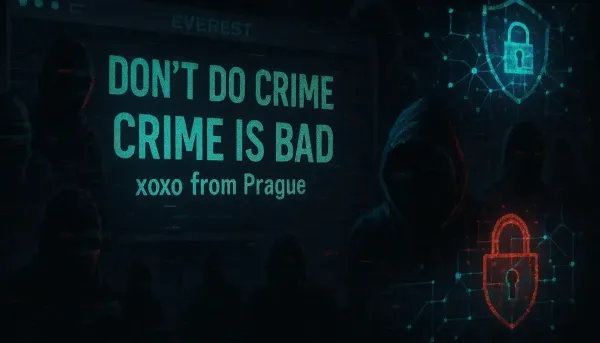
Everest Ransomware Gang Site Takedown- Insights for CISOs
In the increasingly volatile landscape of cybercrime, the recent takedown of the Everest ransomware gang’s dark web leak site has stirred significant conversation within the cybersecurity community. This incident, which saw the gang’s leak site defaced and taken offline, not only illustrates the vulnerability of even the most notorious ransomware operations but also highlights the evolving tactics in the perpetual cat-and-mouse game between cyber criminals and law enforcement.
Launched in 2020, the Everest ransomware group has made its mark by employing dual extortion techniques—stealing data before encrypting the victim’s systems and threatening to publish sensitive information if ransoms are not paid. This approach has positioned Everest as one of the more formidable players within the ransomware landscape, targeting a wide array of sectors including healthcare, logistics, and retail. The recent incident where its leak site was defaced further underscores the ongoing complexities in cybersecurity and the vulnerabilities present in even the darkest corners of the digital underworld.
The Incident: Defacement and Implications
Reports indicate that over the weekend, an unknown attacker succeeded in breaching Everest’s dark web leak site, replacing its contents with a blunt message: “Don’t do crime CRIME IS BAD xoxo from Prague.” The aftermath of this breach saw the site rendered completely inaccessible, displaying an “Onion site not found” error to would-be visitors.
Exploitation Tactics: A Possible WordPress Vulnerability
Expert analysis was quick to suggest that the hacker may have exploited a WordPress vulnerability, given that Everest was utilizing a WordPress template for its blog. As articulated by Flare Senior Threat Intelligence Researcher Tammy Harper, such vulnerabilities are not uncommon and present a pertinent area of risk for organizations that may underestimate the necessity of robust cybersecurity measures, particularly when employing common content management systems (CMS).
The Evolution of Everest’s Tactics
Since its inception, the Everest ransomware operation has demonstrated a notable evolution in its methods. Initially focused solely on data theft, the group has transitioned to a more complex approach that includes ransomware attacks. This strategic shift has allowed Everest to capitalize on the growing trend of double-extortion ransomware techniques, hence amplifying the pressure on victims to capitulate to ransom demands. As of January 2024, Everest had reportedly compromised over 230 organizational victims, making it one of the more prolific ransomware gangs currently operating.
Notable Cases
-
STIIIZY: One of Everest’s more recent high-profile targets was STIIIZY, a California-based cannabis brand that faced a breach attributed to compromised point-of-sale systems. The breach resulted in the exposure of customer identification details and purchase data, further demonstrating the wide-ranging impacts of ransomware operations.
-
Healthcare Sector: The U.S. Department of Health and Human Services has issued alerts regarding Everest’s increased targeting of healthcare entities, raising alarms about the implications for patient confidentiality and the integrity of healthcare infrastructures.
Current Context and Broader Implications
As ransomware attacks have burgeoned, so too have the countermeasures by cybersecurity professionals and law enforcement. The defacement of Everest’s leak site opens discourse on the effectiveness of current strategies against ransomware. Some pivotal considerations include:
Defensive Strategies
-
Robust Monitoring and Response: Continuous monitoring of the dark web for potential threats can provide organizations with early warnings of planned attacks.
-
Ransomware Incident Response Plans: Developing and regularly updating incident response plans is critical for organizations to mitigate the impacts of potential ransomware incidents.
-
Vulnerability Management: Ensuring robust patch management and vulnerability assessments on web applications and other infrastructure components can prevent exploitation.
Industry Collaborations
Cross-industry collaborations and intelligence sharing have become increasingly vital in combatting ransomware threats. Initiatives like the Ransomware Task Force emphasize the importance of a collective approach to confronting these challenges at a global scale.
Conclusion
The takedown of the Everest ransomware gang’s dark web leak site not only underscores the vulnerabilities hackers encounter, even in their own domains but also illuminates ongoing challenges in mitigating ransomware threats. The incident serves as a stark reminder of the need for organizations to prioritize cybersecurity and employ adaptive defenses as cybercriminal tactics continue to evolve.
As the landscape of cyber threats evolves, it becomes increasingly critical for CISOs and IT security professionals to remain vigilant. Continuous investment in cybersecurity infrastructure, expert collaboration, and proactive incident response planning is not merely recommended; it is essential in safeguarding against the evolving threats posed by ransomware and other cybercriminal enterprises.
As we move forward, the importance of resilience in the digital landscape only grows, emphasizing the need for an agile and informed approach to cybersecurity threats.